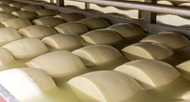Why Salt in Cheese Matters
19th Jun 2025
Why Every Cheese Needs Salt
We often receive emails asking for “cheese without salt”. That got us thinking: do people really know what they’re eating—and why salt is non-negotiable in cheesemaking? Salt isn’t merely a seasoning; it’s a structural pillar that shapes flavour, safety, and texture.
1. Flavour Enhancer
Salt amplifies a cheese’s natural savoury notes, highlights its gentle milk sweetness, and balances acidity. Without it, cheese tastes flat—sometimes even bitter.
2. Moisture Regulator & Texture Controller
By drawing whey out of the curd, salt firms the paste—vital for hard, long-aged cheeses. It also helps curds shrink evenly, locking in the final texture.
3. Microbial Control & Safety
Salt keeps harmful bacteria and moulds at bay while giving beneficial cultures the upper hand. It slows lactic fermentation, stopping cheese from becoming overly sour or spoiled.
4. Rind Development & Maturation
Whether applied dry or via brine, salt creates and preserves rinds. It encourages white-mould blooms on Brie yet hardens protective rinds on Parmesan and Gouda.
5. Shelf-Life & Preservation
Salt is nature’s preservative. By binding moisture, it limits pathogen growth—crucial for safe ageing and storage, just as it was before refrigeration.
How Cheesemakers Add Salt
-
Dry salting – Crystals rubbed onto the surface (e.g., Camembert).
-
Salting the curd – Fine salt mixed through milled curds before moulding (classic Cheddar).
-
Brining – Whole cheeses soaked in a salt solution for uniform penetration (Feta, Gouda).
What kind of salt?
Cheesemakers favour non-iodised dairy salt: pure sodium chloride with no bitter anti-caking agents. Grain size matters—fine grains dissolve swiftly; coarser flakes add crunch where desired.
The Chemistry in Brief
Through osmosis, salt pulls water from curds and microbes, slowing unwanted activity. This controlled dehydration lets proteins and fats mature gracefully, creating the complex flavours and textures we love.
Cheddar in focus: After cutting, draining, and milling, cheesemakers add 1–3 % salt by curd weight. It draws out residual whey, sharpens flavour, and halts excess acid development. Skip the salt and cheddar turns crumbly, sour, and dull.
But Isn’t Cheese Salty?
Cheese does contain salt—but usually in modest amounts, especially when you consider portion size. A standard serving of cheese (about 30g) contributes only a fraction of your recommended daily salt intake.
Here’s how much salt is typically found in 100g of cheese:
-
Brie: 1.2–1.5g salt
-
Cheddar: 1.8–2.2g salt
-
Feta: 2.5–3.0g salt
-
Parmigiano: 1.6–2.0g salt
-
Mozzarella (fresh): 0.4–0.7g salt
Compare that to processed snacks or takeaway foods, and cheese hardly seems excessive.
Balancing Health & Enjoyment
Salt is vital to the structure and safety of cheese. While some styles contain more than others, sensible portions and a balanced diet put things into perspective. For those watching sodium, there are lower-salt varieties available—or simply enjoy smaller servings of your favourites.
Key Takeaways
Salt isn’t sprinkled on as an afterthought—it’s a precise, indispensable ingredient that underpins every great cheese, from a creamy Brie to a crumbly Cheddar. And the amount you’re actually eating? Probably less than you think.
| Role | Benefit |
|---|---|
| Taste | Enhances savoury depth, balances acidity |
| Moisture & Texture | Controls whey loss, curd shrinkage |
| Microbial Management | Fosters good cultures, suppresses bad |
| Rind & Ageing | Shapes the rind, guides maturation |
| Preservation | Extends shelf-life and food safety |
| Additional Links | - The Importance of Salt in Cheesemaking - Why is Salt Added as an Ingredient When Making Cheese? Well, It's Not Just For Flavour? - Salt in Cheese: Physical, Chemical and Biological Aspects |

